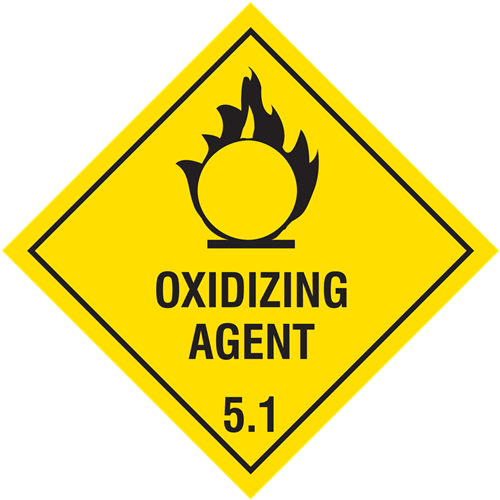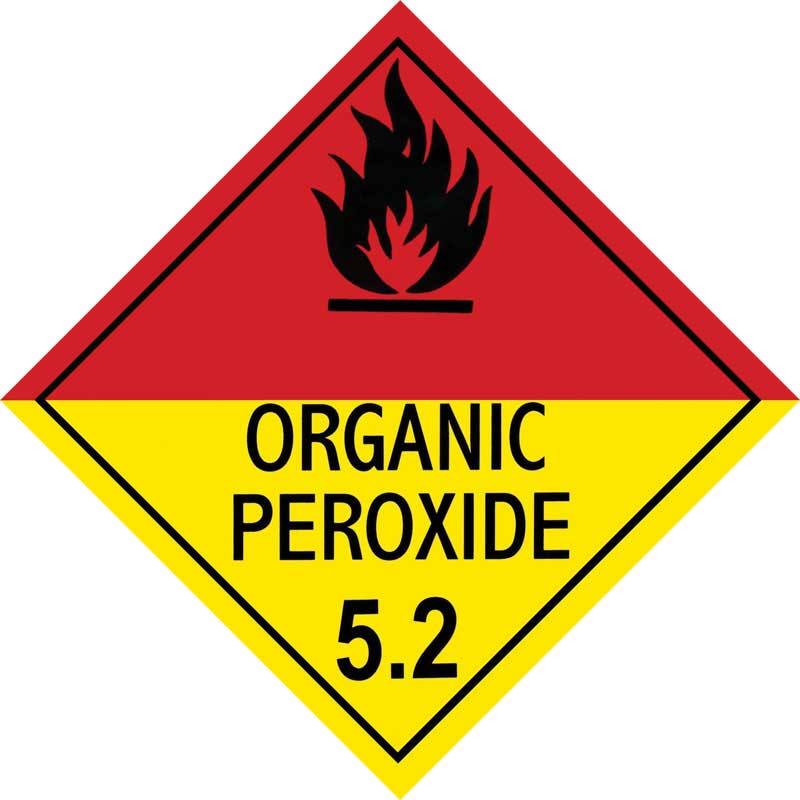What are Oxidising Agents and Organic Peroxides?
As the name suggests, oxidising agents are substances that have the ability to facilitate oxidation reactions. Oxidation refers to a chemical process in which a substance donates oxygen or other oxidising elements to another substance, resulting in the combustion or degradation of the latter. Oxidising agents themselves don’t necessarily burn or combust, but they’re able to assist such reactions in other materials. Examples of common oxidising agents include hydrogen peroxide, potassium permanganate, and sodium chlorate.

Organic peroxides belong to a subclass of oxidising agents. They’re characterised by their potential for explosive decomposition. This means that under certain conditions, such as heat, shock, or contact with incompatible materials, they can undergo rapid and sometimes violent decomposition, releasing gases or causing explosions. Organic peroxides are widely used in various industrial processes, particularly in polymerisation reactions and the curing of plastics and resins. Examples of organic peroxides include benzoyl peroxide, methyl ethyl ketone peroxide, and cumene hydroperoxide.

Regulations and Compliance for Transporting Class 5 Goods
The transportation of dangerous goods, including Class 5 substances, is regulated by various government bodies to ensure safety and protect the environment. The primary authority responsible for overseeing the transport of dangerous goods is the Australian Dangerous Goods Code (ADG Code). This code outlines the requirements for packaging, labelling, handling, and transporting dangerous goods, including oxidising agents and organic peroxides.
Let’s review some key points covered by the ADG Code in relation to these substances.
Classification
The ADG Code classifies oxidising agents and organic peroxides as Class 5 dangerous goods due to their oxidising properties and potential hazards. This classification is essential for ensuring their safe transportation. By categorising them appropriately, the ADG Code helps to mitigate risks and ensure compliance with regulations and guidelines.
Packaging
The Code outlines packaging requirements, specifying the type of packaging materials and construction necessary to withstand the chemical properties and potential reactivity of these Class 5 dangerous goods. Proper packaging helps minimise the risk of leaks, spills, or other accidents during transportation.
Compatibility and Segregation
The ADG Code provides guidelines on compatibility and segregation to prevent the mixing of Class 5 dangerous goods with incompatible substances. It outlines segregation requirements and separation distances to reduce the potential for hazardous reactions. Segregation measures help ensure the safety of both the transported goods and those handling them.
Labelling
Accurate and clear labelling is essential for identifying packages containing oxidising agents and organic peroxides. The ADG Code specifies the required hazard labels, including the proper hazard class, UN identification number, and any additional precautionary information. This enables handlers and emergency responders to quickly identify the nature of the goods and take appropriate safety measures.
Handling and Storage
The ADG Code provides guidelines for the safe handling and storage of oxidising agents and organic peroxides. It emphasises the importance of training personnel involved in the transportation process to ensure they have the knowledge and skills required to handle these substances safely. Proper storage practices, including ventilation requirements, are also addressed to minimise the risk of exposure to toxic fumes or gases.
Emergency Response
The Code outlines procedures for responding to emergencies involving oxidising agents and organic peroxides. It emphasises the need for a thorough emergency response plan, which includes emergency contact information and appropriate actions to take in case of spills, leaks, or other accidents.
By following the guidelines and regulations outlined in the ADG Code, freight operators and individuals involved in transporting Class 5 dangerous goods can remain legally compliant and that prioritise the safety of workers, the public, and the environment.
In addition to the ADG Code, ensure you are familiar with the laws and regulations enforced where you are operating. For example, for Class 5 dangerous goods transport in Victoria, you should familiarise yourself with the guidelines and regulations on Work Safe Victoria, whereas if you’re transporting Class 5 dangerous goods in Queensland, you should be familiar with the laws and regulations mentioned at Work Safe Queensland.
Other Measures for Transporting Class 5 Dangerous Goods Safely
The ADG Code’s requirements cover the safety side of things very well, but there are also some more measures that personnel can implement to ensure a smoother and safer transport of these dangerous goods.
- Training and awareness: All personnel involved in the transport of dangerous goods should receive comprehensive training on the risks associated with Class 5 dangerous goods. This includes knowledge of proper handling procedures, emergency response protocols, and the use of PPE. PPE may include coveralls, chemical-resistant gloves, safety goggles, and a respirator with appropriate filters.
- Documentation and compliance: Ensure you have accurate documentation, including transport manifests and safety data sheets before transporting Class 5 dangerous goods. Maintaining up-to-date records ensures efficient inspections and emergency response coordination.
- Continuous monitoring and maintenance: Regular inspections of transportation vehicles, including tanks or containers, should be conducted to ensure they meet the required safety standards. Regular maintenance and servicing help identify and address potential issues before they escalate.
Class 5 Dangerous Goods Freight Company
Transporting Class 5 dangerous goods in Australia requires adherence to regulations, comprehensive training, and the implementation of safety measures. By following the guidelines outlined in the ADG Code, packaging goods appropriately, and ensuring proper handling and storage, the risks associated with transporting oxidising agents and organic peroxides can be effectively managed.
Need to Transport Class 5 Dangerous Goods in Australia?
There are strict limitations and guidelines to what, and how much of a dangerous material can be transported by a carrier, so be sure to declare the Dangerous Goods when requesting a quote online. Freight Quote Australia is able to arrange transport of most Dangerous Goods, however, we will require the UN number, Class, Packing Group, and Weight of the goods in order to quote and book your freight.
This information is general in nature and we accept no responsibility for consequences arising from the use or reliance on this article. If you need assistance transporting oxidising agents and organic peroxides, please feel free to submit a Quote Request.

